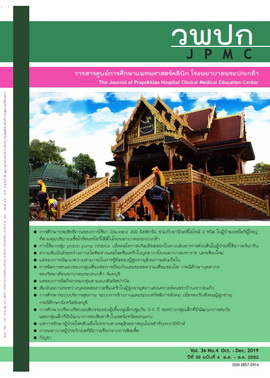Nursing Care for Crisis Patients Who Have a Septic Shock
Main Article Content
Abstract
Septic shock is a significant crisis condition of patients who experience severe infection and develop a systemic response to inflammation of the body. The progression of septic shock is rapid and leads to high morbidity. The patient with crisis septic shock must be diagnosed quickly at an early stage and must receive the care that can help them to recover safely from the incidence of shock. The registered nurse is a key person to provide care to crisis septic shock patients by using the nursing process including assessment, nursing diagnosis, planning, intervention, and evaluation, as well as cooperating with a multidisciplinary team, and particularly physicians. Therefore, nurses should have appropriate knowledge and be able to care for patients with septic shock correctly to reduce the severity of the symptoms. Consequently, the patient is safe from the critical stage. This article aims to review the current knowledge of septic shock in order to help nurses to provide care based on the correct body of knowledge that will help the patient to remain safe from septic shock.
Article Details
References
Singer M, Deutschman CS, Seymour CW, Shankar-Hari M, Annane D, Bauer M, et al. The third international consensus definitions for sepsis and septic shock (sepsis-3). JAMA 2016;315:801-10.
Kochanek KD, Murphy SL, Xu J, Tejada-Vera B. Deaths: final data for 2014. Natl Vital Stat Rep 2016;65: 1–122.
Liu V, Escobar GJ, Greene JD, Soule J, Whippy A, Angus DC, et al. Hospital deaths in patients with sepsis from 2 independent cohorts. JAMA 2014;312: 90-2.
Fleischmann C, Thomas-Rueddel DO, Hartmann M, Hartog CS, Welte T, Heublein S, et al. Hospital incidence and mortality rates of sepsis. Dtsch Arztebl Int 2016;113:159–66.
Mahavanakul W, Nickerson EK, Srisomang P, Teparrukkul P, Lorvinitnun P, Wongyingsinn M, et al. Feasibility of modified surviving sepsis campaign guidelines in a resource restricted setting based on a cohort study of severe S. aureus sepsis. PLoS One [Internet]. 2012 [cited 2019 Jan 14] ;7(2): e29858: Available form: https://journals.plos.org/plosone/article/file?id=10.1371/journal.pone.0029858&type=printable
Amphon K, Bunyoprakarn C, Sinkincharoen P. The outcomes of the development of the patients with septicemia, Prapokklao Hospital. J Prapokklao Hosp Clin Med Educat Center 2017;34:222-36.
Miller RR, Dong L, Nelson NC, Brown SM, Kuttler KG, Probst DR, et al. Multicenter implementation of a severe sepsis and septic shock treatment bundle. Am J Respir Crit Care Med 2013;188:77-82.
Dellinger RP, Levy MM, Rhodes A, Annane D, Gerlach H, Opal SM, et al. Surviving sepsis campaign: international guidelines for management of severe sepsis and septic shock 2012. Intensive Care Med 2013;39:165-228.
American College of Chest Physicians/Society of Critical Care Medicine Consensus Conference: definitions for sepsis and organ failure and guidelines for the use of innovate therapies in sepsis. Crit Care Med 1992;20:864-74.
Russell JA, Rush B, Boyd J. Pathophysiology of Septic Shock. Crit Care Clin 2018; 34:43.61.
Okamoto K, Tamura T, Sawatsubashi Y. Sepsis and disseminated intravascular coagulation. J Intensive Care [Internet]. 2016 [cited 2019 Jan 20];4:23: Available from: https://jintensivecare.biomedcentral.com/track/pdf/10.1186/s40560-016-0149-0
Sarkar M, Niranjan N, Banyal PK. Mechanisms of hypoxemia. Lung India 2017;34:47-60.
Vincent JL, De Backer D. Circulatory shock. N Engl J Med 2013;369:1726-34.
Proudfoot AG, McAuley DF, Griffiths MJ , Hind M. Human models of acute lung injury. Dis Model Mech 2011;4:145-53.
Basile DP, Anderson MD, Sutton TA. Pathophysiology of acute kidney injury. Compr Physiol 2012;2:1303-53.
Keeley A, Hine P, Nsutebu E. The recognition and management of sepsis and septic shock: a guide for non-intensivists. Postgrad Med J 2017;93:626–34.
Van Zanten AR, Brinkman S, Arbous MS, Abu-Hanna A, Levy MM, de Keizer NF. Guideline bundles adherence and mortality in severe sepsis and septic shock. Crit Care Med 2014;42:1890-98.
Noparith P, Traiyawong S, Koteprom J. A development of nursing care model for sepsis patients in Mukdahan Hospital. Journal of Nursing and Health Care 2019;37(1):221-30.
Thiemsuwan Y, Malahom O, Yindesuk T, Kwanchang P, Prasertsri N. The development caring system of critical sepsis patients by case management at Sunprasithtiprasong Hospital, Ubon Ratchathani. Journal of Nursing and Health Care 2017;35(1):184-93.
Rhodes A, Evans LE, Alhazzani W, Levy MM, Antonelli M, Ferrer R, et al. Surviving sepsis campaign: international guidelines for management of sepsis and septic shock: 2016. Intensive Care Med 2017;43:304-77.
Wadelek J. Diagnosis and treatment of patients in septic shock. New Medicine 2017;21:31-6.

